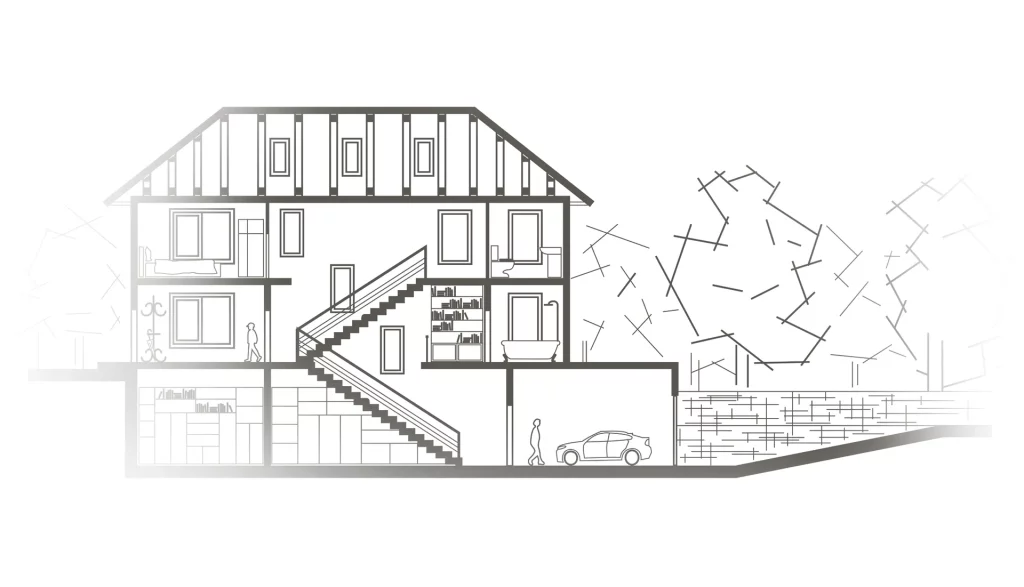Vibration in Buildings
Vibrations in buildings can lead to both physical and psychological discomfort in humans. Conducting vibration measurements assesses and mitigates excessive vibrations ensuring a safe and comfortable environment.
Vibrations in buildings can lead to both physical and psychological discomfort in humans. Conducting vibration measurements assesses and mitigates excessive vibrations ensuring a safe and comfortable environment.
Vibration in Buildings affects Humans due to mechanical waves interacting with body structures. Vibrations can be transmitted to a human body through a building’s structure, making humans passive recipients of these vibrations. High levels of vibrations can be dangerous and lead to health disorders such as vibration disease or vibration syndrome, vascular disorders, neurological issues, or problems with the skeletal system. Humans are exposed to resonant vibrations that can cause symptoms such as nausea, weakness, dizziness, joint and muscle pain, and cramps. Vibrations are also part of the stimuli causing motion sickness.


Vibration in Buildings Measurement Standards depends on the country. Main Vibration standards that define measurements of humans in buildings are:
ISO 2631-2: This international standard is widely used across the EU. It uses the root mean square (RMS) value of the vibration with Wm weighting to quantify human exposure to whole-body vibration in buildings.
BS 6472-1: Predominantly used in the United Kingdom, this standard uses the Vibration Dose Value (VDV), a metric that is more sensitive to short duration, high-level vibrations, which are typically the most annoying or disturbing to people.
DIN 4150-2: Adopted in Germany, this standard uses the KörperBeurteilungspegel (KB) level, a unit that assesses the effects of short and long-term vibrations on buildings and humans within.
Each of these standards has its own method of assessing and limiting vibrations to ensure the safety and comfort of building occupants.
Vibrations in Buildings Sources generate vibrations continuously or periodically, and their distance to the building can be constant or variable. Sources of vibration can be inside the building, such as running machinery or ventilation, and they can also be sources outside the building, such as the passage of heavy vehicles, trains or streetcars, or construction sites. People can be passive recipients of vibrations, meaning that they have no direct influence on the vibration source. If a building is exposed to vibrations then through the structure it can also transmit them to people inside the building. Mechanical waves transmitted through the structure turn into acoustic waves, which we hear inside or affect us directly in the form of vibrations.

To Assess Vibration in Buildings the right choice of evaluation criteria, appropriate indicators, and vibration measurement standards is necessary. Vibration sources, such as operating machinery or vehicles on roads, can impact people in buildings and should be evaluated using effective vibration values in 1/3-octave bands, RMS, or VDV – vibration dose value.
Two methods of Vibration in Building measurements are evaluation in 1/3 octave and evaluation based on weighted values (RMS or VDV). The key difference between the two approaches is the level of detail: the 1/3 octave analysis gives detailed information on vibration at different frequencies, while the RMS and VDV provide a single overall measure of vibration level or dose. The appropriate vibration measurement method to use depends on the specific application and measurement standard.


Vibration comfort is the level of vibration that allows individuals within a building to carry out their specific activities comfortably and effectively, without experiencing adverse effects from excessive or disturbing vibrations. These thresholds of acceptable vibrations ensure that the quality of life, productivity, and overall well-being of the occupants are not compromised.
Several indicators are used to assess vibration comfort in buildings, including the following:
RMS (Root Mean Square): This is a statistical measure that quantifies the magnitude of the vibratory motion. RMS provides a measure of the energy content of the vibration, useful for determining overall levels of vibration.
VDV (Vibration Dose Value): The VDV is an indicator that accounts for both the amplitude and the duration of the vibration, and is more sensitive to short-duration, high-amplitude vibrations than the RMS measure. VDV represents cumulative exposure over a certain period and is used to estimate the probability of adverse comments from people exposed to the vibration.
Frequency Analysis (1/3 Octave Bands): Breaking down the total vibration into different frequency bands can give more detailed information about the vibration characteristics. Certain frequencies can be more disturbing or damaging to human health than others.
Maximum Transient Vibration Value (MTVV): This is used to assess short-term, intermittent vibrations, which can also cause discomfort or damage.
Crest Factor: This is the ratio of the peak value to the RMS value. A high crest factor could indicate a vibration with sharp peaks, which might cause discomfort or damage even if the RMS value is relatively low.
Dominant Frequency: This is the frequency at which the highest level of vibration occurs. Some frequencies can be more disturbing or harmful than others, and so knowing the dominant frequency can be useful.
Vibration Dose Value (VDV) is a parameter for assessing the likelihood of people filing complaints about nuisance vibrations in buildings. Essentially, it’s a measure that predicts how likely the building’s occupants are to find the vibrations bothersome or disturbing. VDV is a measure used to quantify human exposure to vibrations, considering the amplitude of the vibration and its duration. It represents the cumulative exposure over a given period and is especially useful for situations where the vibration levels fluctuate significantly. VDV is more sensitive to short-duration, high-level vibrations, which are typically the most annoying or disturbing to people, making it a key parameter in assessing human comfort and safety in vibrating environments, such as buildings exposed to traffic or industrial activity.


Evaluating vibrations in buildings based on the Vibration Dose Value (VDV) involves several steps:
Measurement: Vibration levels are measured or predicted over a specified duration, typically 16 hours for the daytime and 8 hours for the night-time in relevant places of interest within the building. These measurements should be appropriately weighted to accurately reflect the human response to vibrations.
Calculation of VDV: The Vibration Dose Value is derived from the measured or predicted vibration levels. VDV considers not just the amplitude of the vibration but also its duration, thus representing the cumulative exposure over the given period.
Evaluation Against Standards: The calculated VDV is then compared to the thresholds defined in relevant standards, such as the ISO 2631-2, BS 6472-1, or country-specific standards. These standards define VDV ranges for different types of rooms (like residential buildings, hospitals, offices, and workshops) and times of the day.
By the BS 6472-1, for residential buildings during a 16-hour day, the VDV ranges are:
For residential buildings during an 8-hour night, the VDV ranges are:
For offices and workshops during a 16-hour day, the VDV ranges should be multiplied by factors of 2 and 4 respectively.
To measure Vibration in Building Frequency the analysis of RMS in ⅓-octave bands is used. By measuring in third-octave bands, it is possible to analyze exactly for which frequencies the values are exceeded, and identify of vibration sources.


Instrumentation used for Vibration in Building Measurements is defined by appropriate standards such as ISO 8041-1, or DIN 45669-1. In practice, the instrumentation for vibration measurement in buildings should adhere to the following requirements:
Sensitivity of Transducers: The sensitivity of the transducers (sensors) used to measure vibration should be at least 1 V/ms-2. This is a measure of how much electrical output signal is produced for a given amount of vibration input.
Resolution of Measurement: The expected resolution of such a measurement is a minimum of 10-4 ms-2 of the effective value of the signal. This is the smallest change in vibration level that the measurement system can detect.
Frequency Range of Recorder: The recorder should capture vibrations from 0.5 Hz upwards. This is the range of frequencies that the system can accurately measure.
Sensor Attachment and Orientation: The sensor should be attached to a measurement disk and should register vibrations in three directions. This is to capture all possible motion of the building, which could occur in any direction.
Measurement Disk: The disk is expected to have a diameter of around 30 cm and weigh 30 kg. It should have three support points. The weight and supports ensure a good coupling between the sensor and the structure, which is necessary for accurate measurements.
A Vibration in Building Report is a comprehensive document that details the procedures, results, and analysis of vibration measurements in a building. Here’s what it typically includes:
Objective of the Measurements: The report should clearly state why the measurements were taken. This could be for routine monitoring, in response to complaints, for the assessment of new machinery, etc.
Methodology and Compliance with Standards: The report must indicate the methods used to take the measurements, and confirm that these methods comply with relevant standards, such as ISO 2631, BS 6472, or DIN 4150.
Sources of Vibration: Description of the sources of vibration, such as machinery, traffic, construction activity, etc., which were present during the measurements.
Equipment Used: Detailed information about the equipment used to take the measurements, including the type of sensors, data acquisition systems, and software used for analysis.
Measurement Points: Information about where the measurements were taken. The measurement points used during the measurements should be clearly identifiable, often using diagrams or photographs to aid this identification.
Results: A summary of the measurement results, usually presented in tabular form, often alongside graphical presentations of the data. These could include time histories, frequency spectra, and statistical analyses of the vibration levels.
Analysis: An interpretation and analysis of the results, explaining what they mean in the context of the objective of the measurements, and drawing conclusions about the impact of the vibrations on the building and its occupants.
Recommendations: If necessary, recommendations for actions to reduce vibrations or for further investigations.
Each report should be prepared in a way that it is clear and easily understandable to the intended audience, which could range from building managers and occupants, to engineers, to regulatory authorities.
